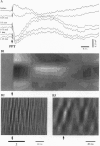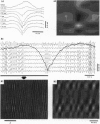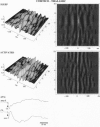Abstract
We report that fast (mainly 30- to 40-Hz) coherent electric field oscillations appear spontaneously during brain activation, as expressed by electroencephalogram (EEG) rhythms, and they outlast the stimulation of mesopontine cholinergic nuclei in acutely prepared cats. The fast oscillations also appear during the sleep-like EEG patterns of ketamine/xylazine anesthesia, but they are selectively suppressed during the prolonged phase of the slow (<1-Hz) sleep oscillation that is associated with hyperpolarization of cortical neurons. The fast (30- to 40-Hz) rhythms are synchronized intracortically within vertical columns, among closely located cortical foci, and through reciprocal corticothalamic networks. The fast oscillations do not reverse throughout the depth of the cortex. This aspect stands in contrast with the conventional depth profile of evoked potentials and slow sleep oscillations that display opposite polarity at the surface and midlayers. Current-source-density analyses reveal that the fast oscillations are associated with alternating microsinks and microsources across the cortex, while the evoked potentials and the slow oscillation display a massive current sink in midlayers, confined by two sources in superficial and deep layers. The synchronization of fast rhythms and their high amplitudes indicate that the term "EEG desynchronization," used to designate brain-aroused states, is incorrect and should be replaced with the original term, "EEG activation" [Moruzzi, G. & Magoun, H.W. (1949) Electroencephalogr. Clin. Neurophysiol. 1, 455-473].
Full text
PDF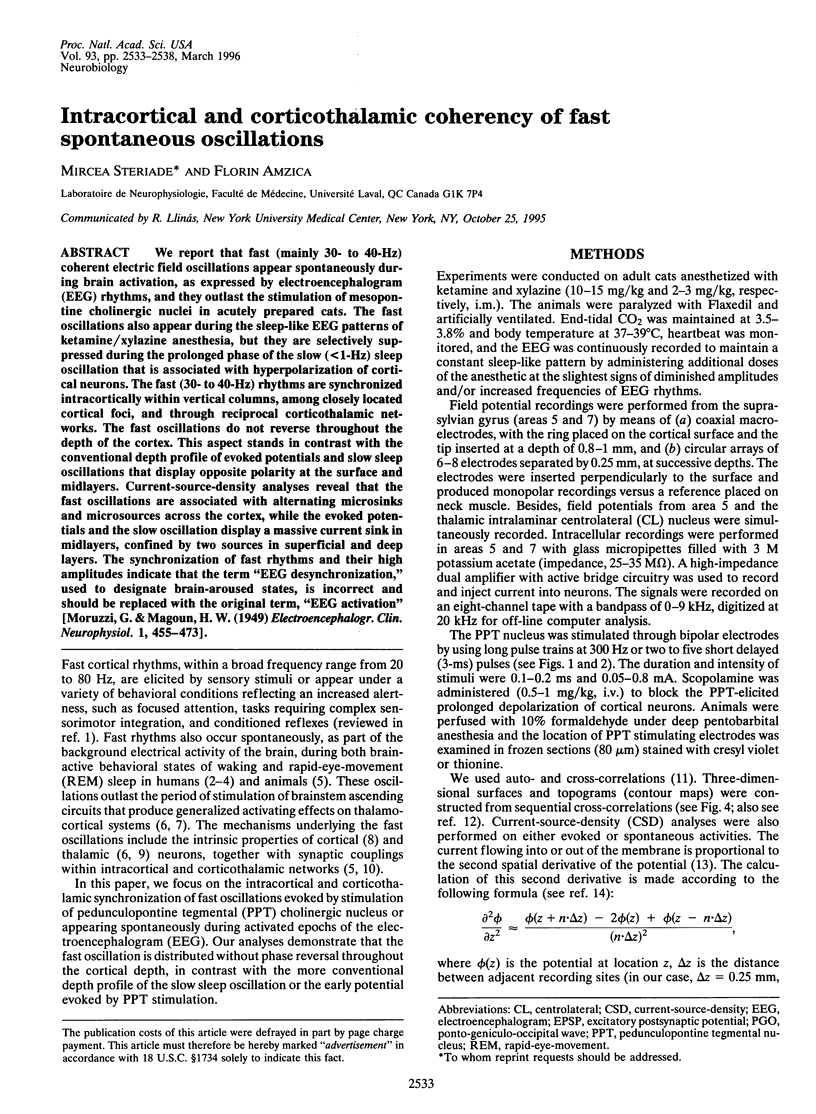
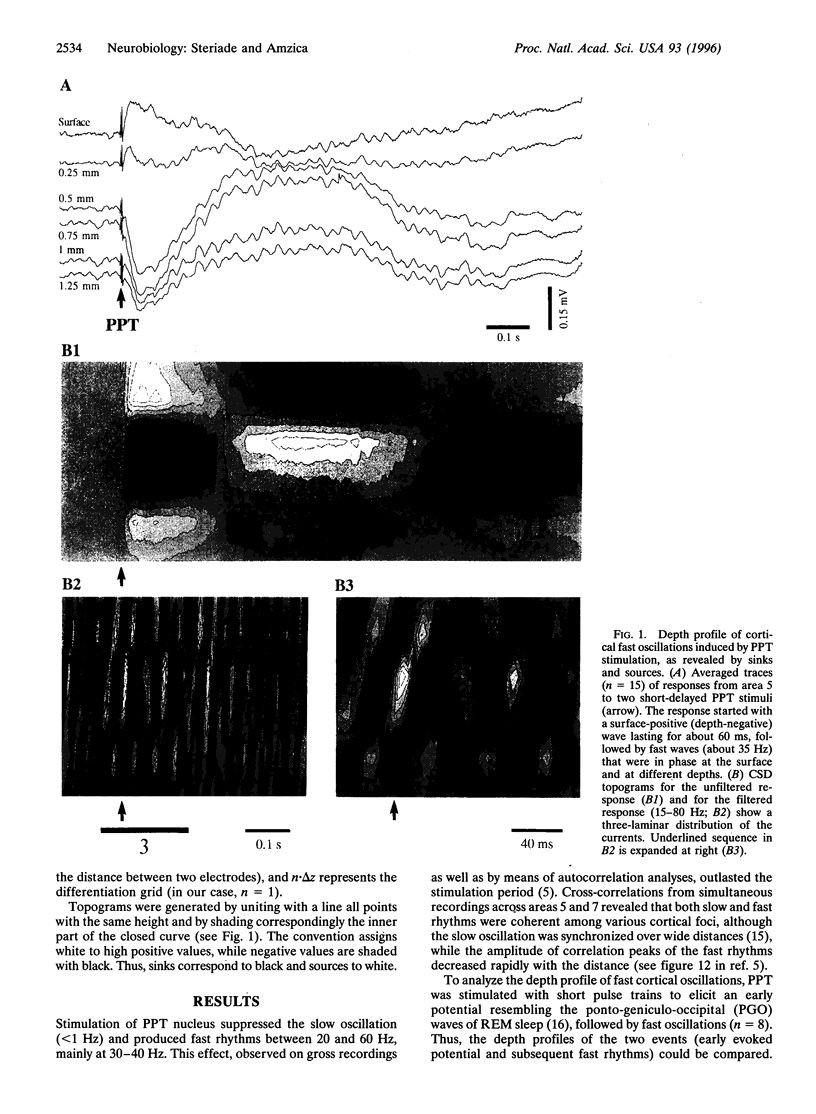
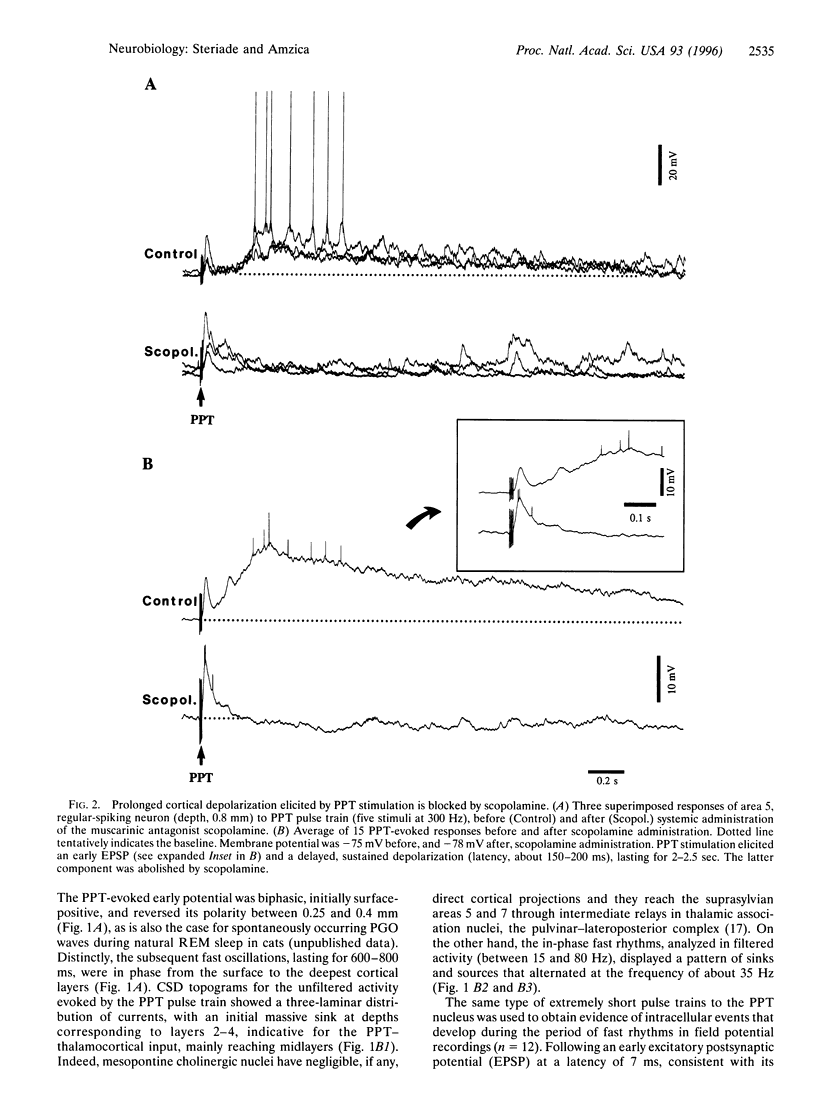
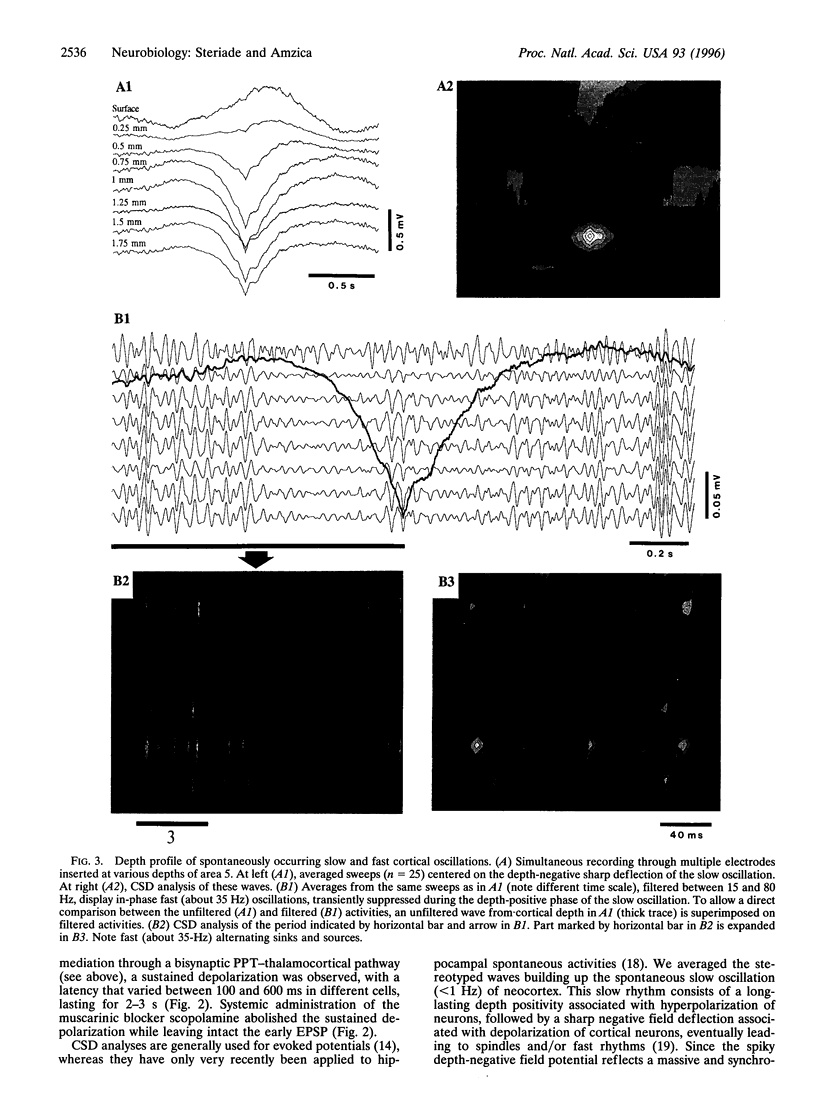
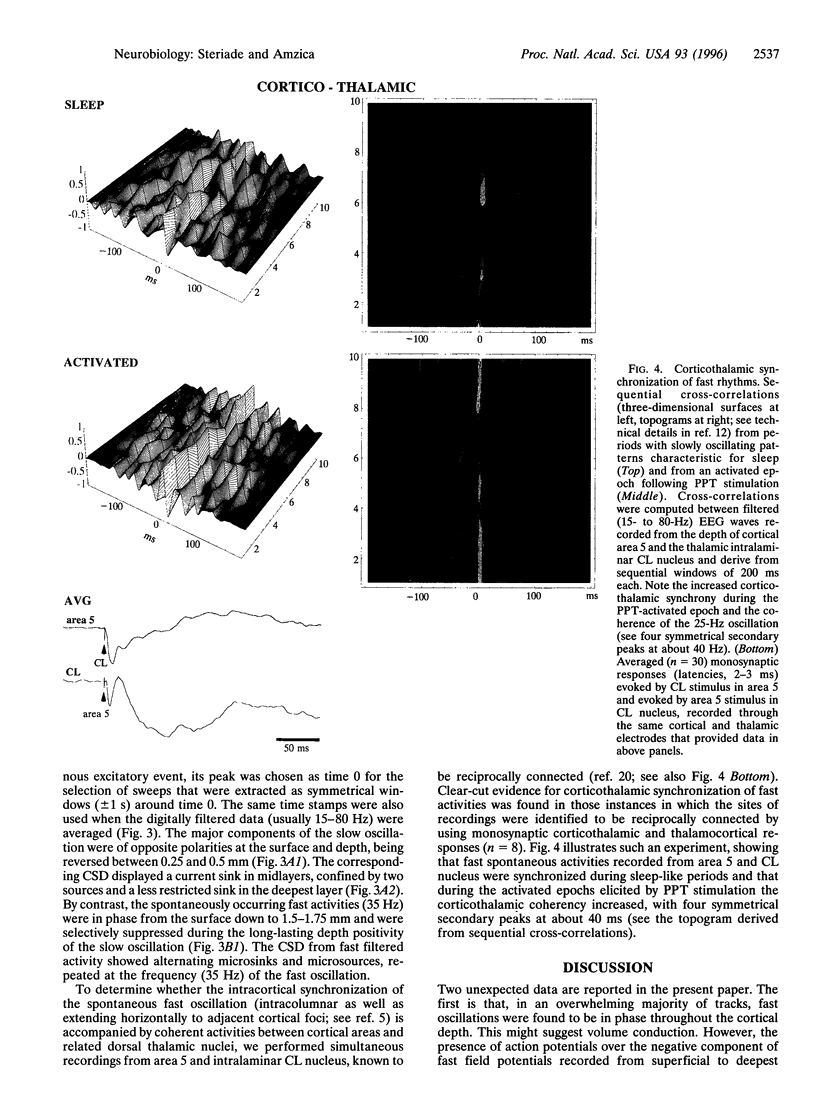
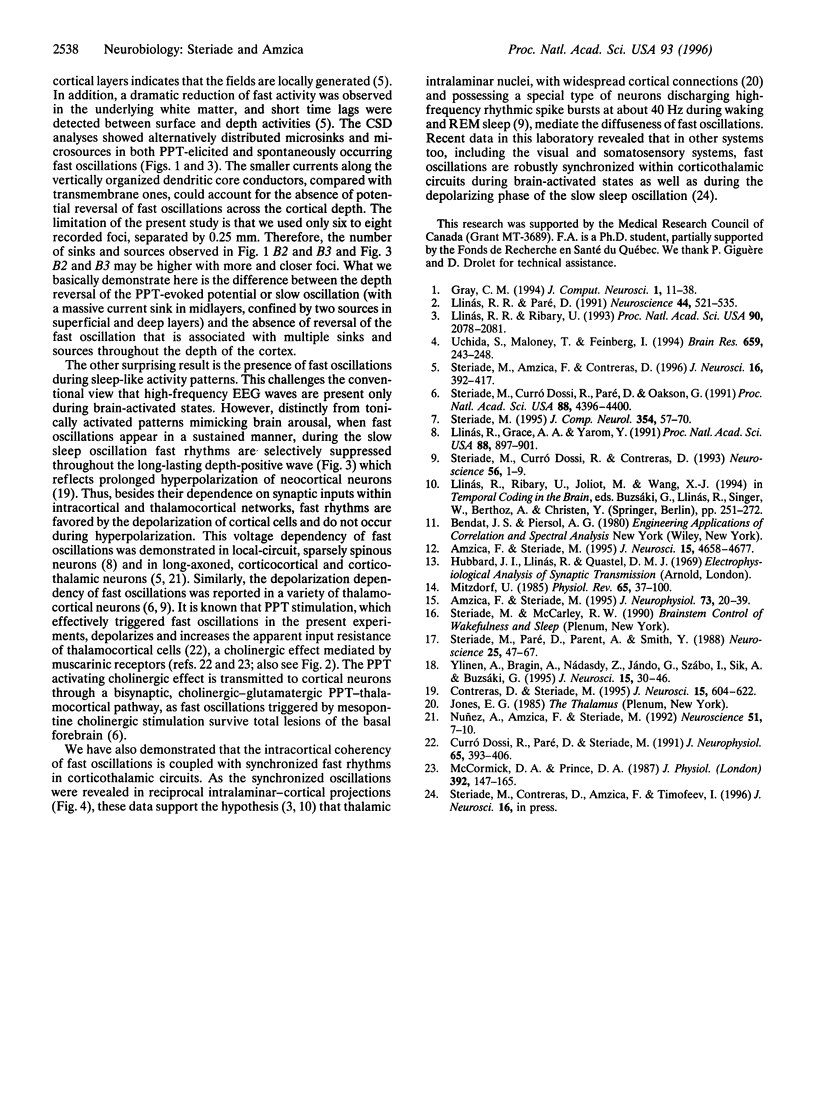
Images in this article
Selected References
These references are in PubMed. This may not be the complete list of references from this article.
- Amzica F., Steriade M. Disconnection of intracortical synaptic linkages disrupts synchronization of a slow oscillation. J Neurosci. 1995 Jun;15(6):4658–4677. doi: 10.1523/JNEUROSCI.15-06-04658.1995. [DOI] [PMC free article] [PubMed] [Google Scholar]
- Amzica F., Steriade M. Short- and long-range neuronal synchronization of the slow (< 1 Hz) cortical oscillation. J Neurophysiol. 1995 Jan;73(1):20–38. doi: 10.1152/jn.1995.73.1.20. [DOI] [PubMed] [Google Scholar]
- Contreras D., Steriade M. Cellular basis of EEG slow rhythms: a study of dynamic corticothalamic relationships. J Neurosci. 1995 Jan;15(1 Pt 2):604–622. doi: 10.1523/JNEUROSCI.15-01-00604.1995. [DOI] [PMC free article] [PubMed] [Google Scholar]
- Curró Dossi R., Paré D., Steriade M. Short-lasting nicotinic and long-lasting muscarinic depolarizing responses of thalamocortical neurons to stimulation of mesopontine cholinergic nuclei. J Neurophysiol. 1991 Mar;65(3):393–406. doi: 10.1152/jn.1991.65.3.393. [DOI] [PubMed] [Google Scholar]
- Gray C. M. Synchronous oscillations in neuronal systems: mechanisms and functions. J Comput Neurosci. 1994 Jun;1(1-2):11–38. doi: 10.1007/BF00962716. [DOI] [PubMed] [Google Scholar]
- Llinás R. R., Grace A. A., Yarom Y. In vitro neurons in mammalian cortical layer 4 exhibit intrinsic oscillatory activity in the 10- to 50-Hz frequency range. Proc Natl Acad Sci U S A. 1991 Feb 1;88(3):897–901. doi: 10.1073/pnas.88.3.897. [DOI] [PMC free article] [PubMed] [Google Scholar]
- Llinás R. R., Paré D. Of dreaming and wakefulness. Neuroscience. 1991;44(3):521–535. doi: 10.1016/0306-4522(91)90075-y. [DOI] [PubMed] [Google Scholar]
- Llinás R., Ribary U. Coherent 40-Hz oscillation characterizes dream state in humans. Proc Natl Acad Sci U S A. 1993 Mar 1;90(5):2078–2081. doi: 10.1073/pnas.90.5.2078. [DOI] [PMC free article] [PubMed] [Google Scholar]
- McCormick D. A., Prince D. A. Actions of acetylcholine in the guinea-pig and cat medial and lateral geniculate nuclei, in vitro. J Physiol. 1987 Nov;392:147–165. doi: 10.1113/jphysiol.1987.sp016774. [DOI] [PMC free article] [PubMed] [Google Scholar]
- Mitzdorf U. Current source-density method and application in cat cerebral cortex: investigation of evoked potentials and EEG phenomena. Physiol Rev. 1985 Jan;65(1):37–100. doi: 10.1152/physrev.1985.65.1.37. [DOI] [PubMed] [Google Scholar]
- Nuñez A., Amzica F., Steriade M. Voltage-dependent fast (20-40 Hz) oscillations in long-axoned neocortical neurons. Neuroscience. 1992 Nov;51(1):7–10. doi: 10.1016/0306-4522(92)90464-d. [DOI] [PubMed] [Google Scholar]
- Steriade M., Amzica F., Contreras D. Synchronization of fast (30-40 Hz) spontaneous cortical rhythms during brain activation. J Neurosci. 1996 Jan;16(1):392–417. doi: 10.1523/JNEUROSCI.16-01-00392.1996. [DOI] [PMC free article] [PubMed] [Google Scholar]
- Steriade M., Dossi R. C., Paré D., Oakson G. Fast oscillations (20-40 Hz) in thalamocortical systems and their potentiation by mesopontine cholinergic nuclei in the cat. Proc Natl Acad Sci U S A. 1991 May 15;88(10):4396–4400. doi: 10.1073/pnas.88.10.4396. [DOI] [PMC free article] [PubMed] [Google Scholar]
- Steriade M., Paré D., Parent A., Smith Y. Projections of cholinergic and non-cholinergic neurons of the brainstem core to relay and associational thalamic nuclei in the cat and macaque monkey. Neuroscience. 1988 Apr;25(1):47–67. doi: 10.1016/0306-4522(88)90006-1. [DOI] [PubMed] [Google Scholar]
- Steriade M. Two channels in the cerebellothalamocortical system. J Comp Neurol. 1995 Mar 27;354(1):57–70. doi: 10.1002/cne.903540106. [DOI] [PubMed] [Google Scholar]
- Uchida S., Maloney T., Feinberg I. Sigma (12-16 Hz) and beta (20-28 Hz) EEG discriminate NREM and REM sleep. Brain Res. 1994 Oct 3;659(1-2):243–248. doi: 10.1016/0006-8993(94)90886-9. [DOI] [PubMed] [Google Scholar]
- Ylinen A., Bragin A., Nádasdy Z., Jandó G., Szabó I., Sik A., Buzsáki G. Sharp wave-associated high-frequency oscillation (200 Hz) in the intact hippocampus: network and intracellular mechanisms. J Neurosci. 1995 Jan;15(1 Pt 1):30–46. doi: 10.1523/JNEUROSCI.15-01-00030.1995. [DOI] [PMC free article] [PubMed] [Google Scholar]



